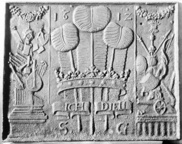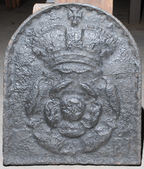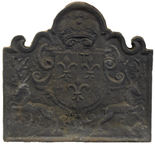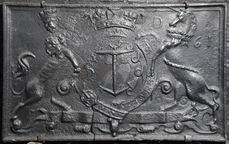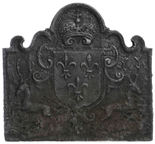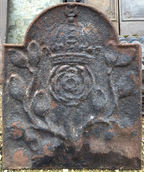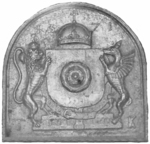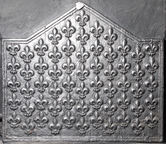-
1291
Description: Rectangular shape; astragal with cavetto-moulded edging; decoration in three vertical sections each divided by a fillet; central section: three ostrich feathers within a coronet and a motto scroll - ICH DIEN (I serve); at the top, the date split either side of the uppermost feather; at the bottom, initials - SG - split either side of the quills; left panel: on a pedestal, an arrangement of musical and scientific instruments and books below a floral swag with a central rose; right panel: on a palisade, a triumph of martial arms - cannon, drum, shield, spear, flag etc. - beneath a floral swag and handful of arrows.
Notes: The three ostrich feathers within a coronet and the motto, Ich Dien, are the badge of the Prince of Wales. Probably a fireback in honour of Henry Frederick, Prince of Wales, oldest son and heir of King James VI of Scotland, I of England, with the date added to commemorate his death in 1612. The initials are likely to be those of the pattern maker.
Inscription: 16 12 / ICH DIEN / S G
- Decoration tags:
- rectangular (shape)
- astragal with cavetto (edging)
- whole carved pattern
- individual numbers
- heraldic
- pictorial
- historical
- architectural
- royal
- text
- objects
Manufactured: in 1612 in the Eifel area of Germany.
Current location: not known.
Museum number: RBA 37533 (part of the Ahrgau-Museum, Ahrweiler museum group)
- Attached to series:
- Prince of Wales firebacks
- Miscellaneous royal firebacks
-
842
Description: Arched shape; cavetto-moulded edging invected on the inner edge; Tudor rose surmounted by a royal crown; monogram in bottom right corner.
Notes: The monogram, RN, is associated with the invected cavetto moulding; a recasting, replicating an earlier crack.
Inscription: RN
- Decoration tags:
- rounded arched (shape)
- scalloped cavetto (edging)
- whole carved pattern
- heraldic
- monogram
- royal
- text
Manufactured: in the early- to mid-17th century in England.
Current location: English Heritage Store, Atcham Business Park, Atcham, Shropshire, England.
Museum number: EH ASC 4490 (part of the English Heritage museum group)
- Attached to series:
- RN series
- Miscellaneous royal firebacks
-
918
Description: Rectangular with complex quasi-arched rectangular top; ovolo moulded edging; shield with Royal arms of France in a swirled cartouche, initials IT top centre; above, an English crown; below to right and left, a prancing stag.
Notes: The combination of the English crown and French arms is common and may relate to the marriage of Charles I and Princess Henrietta Maria of France in 1625; although the framing of the pattern is very similar to others of the same basic design, the style suggests a different pattern maker. A variant of an otherwise identical fireback, with the addition of the date and initials. Bonhams sale, Chester, 25 July 2013, lot 257.
Copies of this fireback are known.
Inscription: IT / 16 [?]1
Arms: France modern
Manufactured: in the early- to mid-17th century possibly in the Weald area of England.
Current location: not known.
- Attached to series:
- Ornate border series
- Miscellaneous royal firebacks
- Anglo-French armorial firebacks
-
220
Description: Rectangular with cavetto moulded edging; English Royal supporters (crowned lion and unicorn) standing upon a cartouche, upon which rests a blank motto scroll; above, an anchor, surrounded by a looped cable is encircled by the Garter ribbon, which is surmounted by a royal coronet; the numbers ‘61’, presumably part of the date, are to the right of the unicorn, and a letter, ‘D’, is placed between the unicorn and the coronet.
Notes: From another casting of the same back, the date is known to be 1661. The cabled anchor is the badge of the Lord High Admiral who, in 1661, was the Duke of York and Albany, later James II. The missing initial is an ‘I’, for Jacobus Dux. The absence of the motto may be explained by the pattern being a carved armorial panel where the motto text, unlike that of the Garter, was merely painted.
Copies of this fireback are known.
Inscription: [I] D / 16 61
Arms: Lord High Admiral of England
- Decoration tags:
- rectangular (shape)
- cavetto (edging)
- whole carved pattern
- individual letters
- individual numbers
- armorial
- text
Manufactured: in 1661 possibly in the Weald area of England.
Current location: Preston Manor, Brighton, East Sussex, England.
Museum number: PM400269 (part of the Brighton Museum museum group)
- Attached to series:
- Miscellaneous royal firebacks
-
824
Description: Rectangular with complex quasi-arched rectangular top; ovolo moulded edging; shield with Royal arms of France in a swirled cartouche; above, an English crown; below to right and left, a prancing stag.
Notes: The combination of the English crown and French arms is common and may relate to the marriage of Charles I and Princess Henrietta Maria of France in 1625; although the framing of the pattern is very similar to others of the same basic design, the style suggests a different pattern maker. Christie's auction 21 Jun 2011 lot 208 (£2,750).
Copies of this fireback are known.
Arms: France modern
- Decoration tags:
- rectangular with round arch (shape)
- ovolo (edging)
- whole carved pattern
- armorial
- animals
Manufactured: in the early- to mid-17th century possibly in the Weald area of England.
Current location: not known.
- Attached to series:
- Ornate border series
- Miscellaneous royal firebacks
- Anglo-French armorial firebacks
-
1037
Description: Arched rectangular shape; fillet edging; central rose with stem and two branches with leaves, surmounted by a crown.
Notes: The rose is more naturalistic than heraldic. Criterion Auctions, Bath, 10 Sep 2016 lot 168.
- Decoration tags:
- rectangular with round arch (shape)
- fillet (edging)
- whole carved pattern
- heraldic
- plants
- objects
Manufactured: in the early- to mid-17th century in England.
Current location: not known.
- Attached to series:
- Miscellaneous royal firebacks
-
269
Description: Arched; cavetto edging; crowned plain shield bearing a Tudor rose, with crowned lion and dragon supporters, with garter and motto; date split by crown.
Notes: The numerals are more typically 16th century in form than are found on copies produced from the late-19th century (see no. 178), suggesting this may be the original design; illustration from Dawson (1903).
Inscription: 15 71 / T K; [English royal, and garter, mottoes].
- Decoration tags:
- rounded arched (shape)
- cavetto (edging)
- whole carved pattern
- individual letters
- individual numbers
- heraldic
- royal
Manufactured: in 1571 in the Weald area of England.
Current location: not known.
Citation: Dawson, C., 1903, 'Sussex Iron Work and Pottery', Sussex Archaeological Collections, 46, pp. 1-54.
- Attached to series:
- Miscellaneous royal firebacks
-
88
Description: Rectangular with triangular arch; stepped fillet edging; eleven columns of fleurs de lys, maximum seven in column, but varied according to space, with fleurs alternated for spacing.
Notes: Whole pattern with five vertical planklines; a field of small fleurs de lys, France Ancient in royal heraldry, might suggest a continental origin.
Copies of this fireback are known.
- Decoration tags:
- rectangular with triangular arch (shape)
- stepped fillet (edging)
- whole carved pattern
- planklines
- heraldic
- objects
Manufactured: in the late-16th to early-17th century possibly in the Weald area of England.
Current location: Hampton Court, Richmond, Greater London, England.
- Attached to series:
- Miscellaneous royal firebacks
- Fleur-de-lys firebacks
-
178
Description: Arched; cavetto edging; crowned plain shield bearing a Tudor rose, with crowned lion and dragon supporters, with garter and motto; date split by crown.
Notes: A much-copied fireback; the numerals are uncharacteristically modern in form, suggesting they have been substituted on a later copy; a variant illustrated by Dawson (no. 269) shows a cross above the crown and more typically 16th century numerals. Formerly part of the Ade Collection (from Grove Hill, Hellingly, Sussex).
Copies of this fireback are known.
Inscription: 1571 HONI SOIT... ...DROI ? K
- Decoration tags:
- rounded arched (shape)
- fillet (edging)
- whole carved pattern
- individual numbers
- heraldic
- royal
- text
Manufactured: in the late-19th to early-20th century possibly in the Weald area of England.
Current location: Hastings Museum and Art Gallery, John's Place, Bohemia Road, Hastings, East Sussex, England.
Museum number: HASMG: 1952.51.45 (part of the Hastings Museum museum group)
- Attached to series:
- Miscellaneous royal firebacks
-
398
Description: Rectangular; cyma curve and fillet edging; crowned Tudor rose within a pediment resting on Tuscan pilasters and pedestals.
Notes: The rose and crown are more finely modelled than other versions.
Copies of this fireback are known.
- Decoration tags:
- rectangular (shape)
- cyma curve and fillet (edging)
- whole carved pattern
- heraldic
- architectural
- royal
Manufactured: in the mid- to late-16th century in the Weald area of England.
Current location: Anne of Cleves House, Southover High Street, Lewes, East Sussex, England.
Museum number: LH000.942 (part of the Sussex Archaeological Society museum group)
- Attached to series:
- Miscellaneous royal firebacks
- Pedimented rose and crown series
